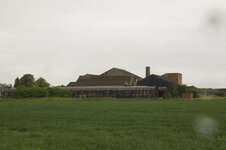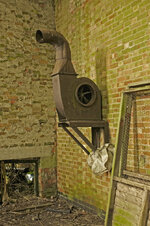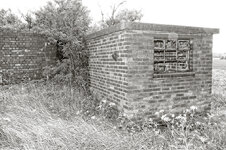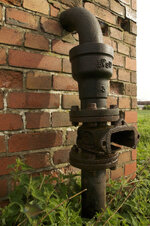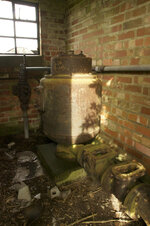Whilst on the way to RAF Coleby Grange a few weeks ago we spotted this beauty from the road. Sited on a private farm near Methringham the sign at the road side labels it as the Flax Factory. It proved very difficult to get any information or pictures of this place on the web. This is the stuff I found:
Rumour suggest that the Flax Factory was built during WW2 in order to meet the War Department's insatiable demand for flax. Flax seeds were used to produce linseed oil and the fibre was used to produce rope. Post war when the demand for flax declined the mill was closed and in recent time used for processing pea vines.
Philip Baumer of Scopwick has kindly sent his reminiscences of times at the Flax factory.
"It was built early in WW2 the brick buildings housed the machinery, and the ten dutch barns to store the flax. This was a new crop to Lincolnshire, the reason being that war was on the way. Much more home grown food would be needed, so many acres of old rough grass would come under the plough, and the chief menace was the "wire worm" grub to corn crops. With no sprays on the market to kill them, a recommendation form the Ministry of Agriculture was one or two crops of flax would clear the soil of the grubs, if the land was to be used for potatoes then a thick lush crop of mustard was ploughed in.
The first drilling of flax was March 1940 while the factory was being built. Given good weather it grew quickly, and by late June it was ready for harvesting, thus being out of the way before the corn harvest. Long strong green storks were pulled by a machine just when the flowers had fallen, pulling the roots because they held fibre it was made into sheaves. Stooking the same as corn it was left to dry until the sheaves were brown, then stacked and thatched.
At the factory the dry sheaves were elevated to the top of the building, so the process began, words like "retted" "scutching" and "green-scutched" were used by the ladies who worked there. In the process some parts were awash with water, and others dry with plenty of dust. Buses conveyed the workers from the surrounding villages, mostly women, who in 1941 processed 8,000 tons from 3,000 acres from the 1941 crop.
Mr William Dalton was the manager, he came from Cottingham near Hull, and was awarded the B E M for his services to flax, he lived at Dunston Pillar
Mrs Ellis of Digby was overseer of the carting and came to the farms with helpers to load the lorries.
The late Mr Eric Parker was chairman of the company. One of the secretaries was Eileen Kew daughter of the Metheringham Station master."
The airfield information exchange have an interesting thread here, rumours of Thor missile involvement etc: Coleby Grange
So, sunday morning, a bit wet so no-one really out and about. We wandered from the road through a beautiful walled area that looked like it was once a cottage garden, now used to house bee hives. Across the field the trees and the flax factory hid us from view from the farm house. We reached the collection of WW2 buildings - the factory and a variety of brick and concrete structures. There was a way in to the factory but we decided against it - the floor looked dodgy and there was so much crap piled there it would have made a right racket! So, we wandered round the outbuildings and a couple of accessible parts of the factory also. There are a few really nice little features, shown below, but the main building looked fairly gutted and collapsing. Although, if anyone else fancies checking it out there are some pulleys and pipes attached to the ceiling that I could see through the window. Forgive the rain spots!
The building from the outside


Looking through the hole in the wall to the interior



Three hanging lamps - really disappointed how this photo came out, so I just processed the shit out of it instead



This is the bit rumoured to be Thor related




The Stanton Shelter at nearby Coleby Grange, revisited, which we missed last time

Rumour suggest that the Flax Factory was built during WW2 in order to meet the War Department's insatiable demand for flax. Flax seeds were used to produce linseed oil and the fibre was used to produce rope. Post war when the demand for flax declined the mill was closed and in recent time used for processing pea vines.
Philip Baumer of Scopwick has kindly sent his reminiscences of times at the Flax factory.
"It was built early in WW2 the brick buildings housed the machinery, and the ten dutch barns to store the flax. This was a new crop to Lincolnshire, the reason being that war was on the way. Much more home grown food would be needed, so many acres of old rough grass would come under the plough, and the chief menace was the "wire worm" grub to corn crops. With no sprays on the market to kill them, a recommendation form the Ministry of Agriculture was one or two crops of flax would clear the soil of the grubs, if the land was to be used for potatoes then a thick lush crop of mustard was ploughed in.
The first drilling of flax was March 1940 while the factory was being built. Given good weather it grew quickly, and by late June it was ready for harvesting, thus being out of the way before the corn harvest. Long strong green storks were pulled by a machine just when the flowers had fallen, pulling the roots because they held fibre it was made into sheaves. Stooking the same as corn it was left to dry until the sheaves were brown, then stacked and thatched.
At the factory the dry sheaves were elevated to the top of the building, so the process began, words like "retted" "scutching" and "green-scutched" were used by the ladies who worked there. In the process some parts were awash with water, and others dry with plenty of dust. Buses conveyed the workers from the surrounding villages, mostly women, who in 1941 processed 8,000 tons from 3,000 acres from the 1941 crop.
Mr William Dalton was the manager, he came from Cottingham near Hull, and was awarded the B E M for his services to flax, he lived at Dunston Pillar
Mrs Ellis of Digby was overseer of the carting and came to the farms with helpers to load the lorries.
The late Mr Eric Parker was chairman of the company. One of the secretaries was Eileen Kew daughter of the Metheringham Station master."
The airfield information exchange have an interesting thread here, rumours of Thor missile involvement etc: Coleby Grange
So, sunday morning, a bit wet so no-one really out and about. We wandered from the road through a beautiful walled area that looked like it was once a cottage garden, now used to house bee hives. Across the field the trees and the flax factory hid us from view from the farm house. We reached the collection of WW2 buildings - the factory and a variety of brick and concrete structures. There was a way in to the factory but we decided against it - the floor looked dodgy and there was so much crap piled there it would have made a right racket! So, we wandered round the outbuildings and a couple of accessible parts of the factory also. There are a few really nice little features, shown below, but the main building looked fairly gutted and collapsing. Although, if anyone else fancies checking it out there are some pulleys and pipes attached to the ceiling that I could see through the window. Forgive the rain spots!
The building from the outside
Looking through the hole in the wall to the interior
Three hanging lamps - really disappointed how this photo came out, so I just processed the shit out of it instead

This is the bit rumoured to be Thor related
The Stanton Shelter at nearby Coleby Grange, revisited, which we missed last time
Attachments
Last edited:

